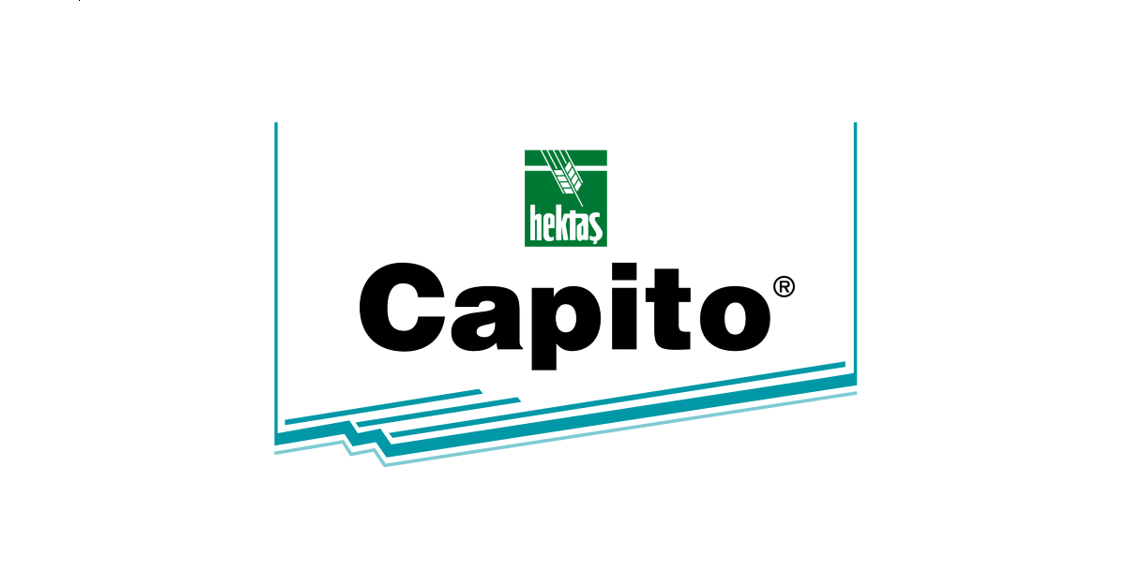Description
Specifications
Capito is an insecticide in suspension concentrate (SC) form, which is a combination of two different active substances. One of these two active substances is Indoxacarb, which is a contact and stomach poison. It acts by blocking the sodium channels of the insects nerve cells; shortly after spraying, the pests nutritional and other activities are ended or significantly reduced. Abamectin is a contact insecticide and acaricide, as well as a stomach poison. While it has limited systemic activity in the plant, it has good translaminar action. This makes it easy to be transported within the leaf, moving inside the leaf and controlling pests.
Method of Application
Corn: The first spraying is done after the first eggs of the pest are seen, followed by 2nd and 3rd sprayings done at 15-day intervals.
Tomato: In order to identify imago emergence, sexual pheromone traps are used in the field as of the start of production season in the field (1-2 traps/ha) and in the greenhouse (1 trap/greenhouse). Traps are checked weekly; when the first imago is seen in the trap, at least 100 plants are checked depending on the size of production area, looking for eggs and larva in flowers, leaves, stems and offshoots. Management is decided if 10/100 plants are contaminated by eggs and larva. Plants are checked again 5-6 days after spraying. Spraying may be repeated if necessary. Spraying should be done in early morning or late afternoon when the weather is calm.
Cotton: Management of cotton bollworm in cotton may be against any generation of this pest. For best results in management with pesticides, spraying should be done when the eggs hatch.The product is effective in all larva stages of the pest. In the cotton field, the plants on 6-8 randomly selected cotton lines of 3 m are checked and bollworm eggs and larva are counted. If there are an average of 2-5 larvae on a line of 3 m, management is decided. Depending on the intensity of pest at the time, spraying may be repeated at a 10-day interval. Spraying should be done in the morning after dew is gone or in late afternoon when the weather calm, by ensuring that all green parts are soaked.
Apple: The aim in apple codling moth management is keeping the trees sprayed at the time of larva emergence in each generation and killing the hatching larvae before entering the fruit. For this, it is recommended to target the pest’s eggs for maximum effectiveness. Capito® is effective against the pest’s larvae and eggs. The tree’s phenology and the pest’s biology (flying moths) should be followed up to determine the timing of spraying; information should also be sought from publishing institutions. 1st spraying should be done when the first generation eggs begin to hatch. Depending on the product’s protective period, a 2nd spraying is done 20-30 days after the 1st one to prevent the harm caused by the first generation. Then, another spraying should be done against second generation, after the first egg of the second generation hatches. Generally, 2 sprayings against the first generation and one against the second generation, totaling 3, are sufficient. Another spraying can be done against the third generation, if required by the pest intensity.
Peach moth :In appointing time of administration against peach twig borer, sexual pheromone traps, total effective temperature and plant phenology is used. In peach moth management, the aim is to kill the larvae before they enter into the shoot or fruit. Administration should be repeated with an interval of 21 days depending on the density of pest.
Pear: The aim in apple codling moth management is keeping the trees sprayed at the time of larva emergence in each generation and killing the hatching larvae before entering the fruit. For this, it is recommended to target the pest’s eggs for maximum effectiveness. Capito® is effective against the pest’s larvae and eggs. The tree’s phenology and the pest’s biology (flying moths) should be followed up to determine the timing of spraying; information should also be sought from publishing institutions. 1st spraying should be done when the first generation eggs begin to hatch. Depending on the product’s protective period, a 2nd spraying is done 20-30 days after the 1st one to prevent the harm caused by the first generation. Then, another spraying should be done against second generation, after the first egg of the second generation hatches. Generally, 2 sprayings against the first generation and one against the second generation, totaling 3, are sufficient. Another spraying can be done against the third generation, if required by the pest intensity.
OTHER INFORMATIONS
Compatibility: It can be mixed with other insecticides and fungicides except for products with alkaline reaction. A trial mix is recommended before large-volume mix preparation for spraying.
Detailed Table Information
| Name of the product | Plant Name | Pest Name | Usage dose | Time between last spraying and harvest | Video |
|---|---|---|---|---|---|
| Capito | Olive |
Codling moth(Prays oleae)
|
70 ml/100 l water larva | 21 day | |
| Capito | Peach |
Peach twig borer(Anarsia lineatella)
|
50 ml/100 L water | 21 day | |
| Capito | Cotton |
Cotton bollworm (Helicoverpa armigera)
|
70 ml/da larva | 14 day | |
| Capito | Corn |
Mediterranean corn stalk borer (Sesamia spp.)
|
60 ml/da | 7 day | |
| Capito | Apple |
Apple codling moth (Cydia pomonella)
|
70 ml/100 L water, Egg, larva | 7 day | |
| Capito | Tomato (Field) |
Tomato leafminer (Tuta absoluta)
|
45 ml/water | 3 day | |
| Capito | Tomato (greenhouse) |
Tomato leafminer (Tuta absoluta)
|
45 ml/da | 3 day | |
| Capito | Pear |
Codling moth(Cydia pomonella)
|
70 ml/100 L su Yumurta, larva | 7 day |

